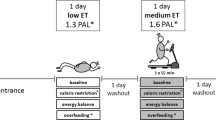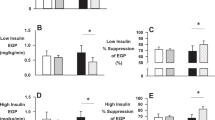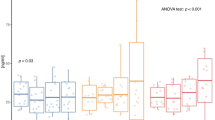Abstract
Objective: Prior exercise has been repeatedly shown to reduce lipemia after meals of exaggerated fat content (over 60% of total energy). The aim of the present study was to investigate whether the same applies to meals closer to the composition of the typical Western diet and explore whether exercise affects the release of dietary fat into the bloodstream.
Design: Randomized counterbalanced.
Setting: Laboratory.
Subjects: Nine healthy young male volunteers.
Intervention: Subjects consumed a meal of moderate fat content (35% of total energy, 0.66 g/kg body mass) 14 h after having either cycled for 1 h at 70–75% of maximal heart rate or rested. Macadamia nuts were used as the main source of dietary fat to trace its entry into the circulation because of their unusual fatty acid composition. Blood samples were drawn before the meal and for 8 h postprandially.
Results: Plasma triacylglycerol concentrations and total area under the triacylglycerol concentration vs time curve (AUC) were significantly lower after exercise (P=0.001 and 0.003, respectively; effect size for the latter, 0.84). However, incremental (above baseline) AUC was not affected by exercise significantly. When controlling for differences in baseline plasma concentrations, only the fatty acids that were more abundant in the meal than in plasma triacylglycerols were decreased in the early postprandial period following exercise, implying either a suppressive effect of exercise on the rate of triacylglycerol release from the intestine or a more rapid chylomicron clearance after meal consumption.
Conclusions: Exercise performed between 15 and 14 h before a meal of moderate fat content reduced postprandial lipemia, mainly by lowering fasting triacylglycerols. The effect of exercise on postprandial triacylglycerol metabolism may be mediated, at least in part, by attenuated release of dietary fat from the intestine.
This is a preview of subscription content, access via your institution
Access options
Subscribe to this journal
Receive 12 print issues and online access
$259.00 per year
only $21.58 per issue
Buy this article
- Purchase on Springer Link
- Instant access to full article PDF
Prices may be subject to local taxes which are calculated during checkout




Similar content being viewed by others
References
Aldred HE, Perry IC & Hardman AE (1994): The effect of a single bout of brisk walking on postprandial lipemia in normolipidemic young adults. Metabolism 43, 836–841.
American College of Sports Medicine (1998): Position stand on the recommended quantity and quality of exercise for developing and maintaining cardiorespiratory and muscular fitness, and flexibility in adults. Med. Sci. Sports Exer. 30, 975–991.
Cohen J (1998): Statistical Power Analysis for the Behavioral Sciences. Hillsdale: Lawrence Erlbaum.
Dole VP (1956): A relation between non-esterified fatty acids in plasma and the metabolism of glucose. J. Clin. Invest. 35, 150–154.
Dubois C, Beaumier G, Juhel C, Armand M, Portugal H, Pauli AM, Borel P, Latgé C & Lairon D (1998): Effects of graded amounts (0–50 g) of dietary fat on postprandial lipemia and lipoproteins in normolipidemic adults. Am. J. Clin. Nutr. 67, 31–38.
Evans K, Burdge GC, Wootton SA, Clark ML & Frayn KN (2002): Regulation of dietary fatty acid entrapment in subcutaneous adipose tissue and skeletal muscle. Diabetes 51, 2684–2690.
Fielding BA, Reid G, Grady M, Humphreys SM, Evans K & Frayn KN (2000): Ethanol with a mixed meal increases postprandial triacylglycerol but decreases postprandial non-esterified fatty acid concentrations. Br. J. Nutr. 83, 597–604.
Frayn KN (1998): Non-esterified fatty acid metabolism and postprandial lipemia. Atherosclerosis 141 (Suppl 1), S41–S46.
Gill JMR, Frayn KN, Wootton SA, Miller GJ & Hardman AE (2001a): Effects of prior moderate exercise on exogenous and endogenous lipid metabolism and plasma factor VII activity. Clin. Sci. 100, 517–527.
Gill JMR & Hardman AE (2003): Exercise and postprandial lipid metabolism: an update on potential mechanisms and interactions with high-carbohydrate diets (review). J. Nutr. Biochem. 14, 122–132.
Gill JMR & Hardman AE (2000): Postprandial lipemia: effects of exercise and restriction of energy intake compared. Am. J. Clin. Nutr. 71, 465–471.
Gill JMR, Herd SL & Hardman AE (2002): Moderate exercise and post-prandial metabolism: issues of dose-response. J. Sports Sci. 20, 961–967.
Gill JMR, Herd SL, Vora V & Hardman AE (2003): Effects of a brisk walk on lipoprotein lipase activity and plasma triglyceride concentrations in the fasted and postprandial states. Eur. J. Appl. Physiol. 89, 184–190.
Gill JMR, Mees GP, Frayn KN & Hardman AE (2001b): Moderate exercise, postprandial lipaemia and triacylglycerol clearance. Eur. J. Clin. Invest. 31, 201–207.
Gill JMR, Murphy MH & Hardman AE (1998): Postprandial lipemia: effects of intermittent versus continuous exercise. Med. Sci. Sports Exer. 30, 1515–1520.
Hardman AE & Aldred HE (1995): Walking during the postprandial period decreases alimentary lipaemia. J. Cardiovasc. Risk 2, 71–78.
Hardman AE, Lawrence JEM & Herd SL (1998): Postprandial lipemia in endurance-trained people during a short interruption to training. J. Appl. Physiol. 84, 1895–1901.
Hardman AE (1998): The influence of exercise on postprandial triacylglycerol metabolism. Atherosclerosis 141 (Suppl 1), S93–S100.
Herd SL, Hardman AE, Boobis LH & Cairns CJ (1998): The effect of 13 weeks of running training followed by 9 d of detraining on postprandial lipaemia. Br. J. Nutr. 80, 57–66.
Herd SL, Kiens B, Boobis LH & Hardman AE (2001): Moderate exercise, postprandial lipemia, and skeletal muscle lipoprotein lipase activity. Metabolism 50, 756–762.
Herd SL, Lawrence JEM, Malkova D, Murphy MH, Mastana S & Hardman AE (2000): Postprandial lipemia in young men and women of contrasting training status. J. Appl. Physiol. 89, 2049–2056.
Holland B, Welch AA, Unwin ID, Buss DH, Paul AA & Southgate DAT (1991): McCance and Widdowson's the Composition of Foods. Cambridge: Royal Society of Chemistry.
Karpe F (1999): Postprandial lipoprotein metabolism and atherosclerosis. J. Intern. Med. 246, 341–355.
Klein L, Miller TD, Radam TE, O’Brien T, Nguyen TT & Kottke BA (1992): Acute physical exercise alters apolipoprotein E and C-III concentrations of apo E-rich very low density lipoprotein fraction. Atherosclerosis 97, 37–51.
Koutsari C & Hardman AE (2001): Exercise prevents the augmentation of postprandial lipaemia attributable to a low-fat high-carbohydrate diet. Br. J. Nutr. 86, 197–205.
Koutsari C, Karpe F, Humphreys SM, Frayn KN & Hardman AE (2001): Exercise prevents the accumulation of triglyceride-rich lipoproteins and their remnants seen when changing to a high-carbohydrate diet. Arterioscler. Thromb. Vasc. Biol. 21, 1520–1525.
Kramer JKG, Fellner V, Dugan MER, Sauer FD, Mossoba MD & Yurawecz MP (1997): Evaluating acid and base catalysts in the methylation of milk and rumen fatty acids with special emphasis on conjugated dienes and total trans fatty acids. Lipids 32, 1219–1228.
Malkova D, Evans RD, Frayn KN, Humphreys SM, Jones PRM & Hardman AE (2000): Prior exercise and postprandial substrate extraction across the human leg. Am. J. Physiol. Endocrinol. Metab. 279, E1020–E1028.
Malkova D, Hardman AE, Bowness RJ & Macdonald IA (1999): The reduction in postprandial lipemia after exercise is independent of the relative contributions of fat and carbohydrate to energy metabolism during exercise. Metabolism 48, 245–251.
Maruhama Y, Abe R, Okuguchi F & Ohmori H (1977): Effect of exercise on alimentary lipemia in healthy men. Tohoku. J. Exp. Med. 122, 183–189.
Murphy MH, Nevill AM & Hardman AE (2000): Different patterns of brisk walking are equally effective in decreasing postprandial lipaemia. Int. J. Obes. 24, 1303–1309.
Petitt DS, Arngrímsson SA & Cureton KJ (2003): Effect of resistance exercise on postprandial lipemia. J. Appl. Physiol. 94, 694–700.
Pettit DS & Cureton KJ (2003): Effects of prior exercise on postprandial lipemia: a quantitative review. Metabolism 52, 418–424.
Schlierf G, Dinsenbacher A, Kather H, Kohlmeier M & Haberbosch W (1987): Mitigation of alimentary lipemia by postprandial exercise-phenomena and mechanisms. Metabolism 36, 726–730.
Seip RL & Semenkovich CF (1998): Skeletal muscle lipoprotein lipase: Molecular regulation and physiological effects in relation to exercise. Exer. Sport Sci. Rev. 26, 191–218.
Thomas TR, Horner KE, Langdon MM, Zhang JQ, Krul ES, Sun GY & Cox RH (2001): Effect of exercise and medium-chain fatty acids on postprandial lipemia. J. Appl. Physiol. 90, 1239–1246.
Tsetsonis NV, Hardman AE & Mastana SS (1997): Acute effects of exercise on postprandial lipemia: a comparative study in trained and untrained middle-aged women. Am. J. Clin. Nutr. 65, 525–533.
Tsetsonis NV & Hardman AE (1996a): Effects of low and moderate intensity treadmill walking on postprandial lipaemia in healthy young adults. Eur. J. Appl. Physiol. 73, 419–426.
Tsetsonis NV & Hardman AE (1996b): Reduction in postprandial lipemia after walking: influence of exercise intensity. Med. Sci. Sports Exer. 28, 1235–1242.
Williams MH (2002): Nutrition for health, fitness and sport. New York: McGraw Hill, 186.
Zhang JQ, Thomas TR & Ball SD (1998): Effect of exercise timing on postprandial lipemia and HDL cholesterol subfractions. J. Appl. Physiol. 85, 1516–1522.
Author information
Authors and Affiliations
Contributions
Guarantor: V Mougios.
Contributors: MK performed the major part of data collection, data analysis, and writing of the manuscript, as this work was her master's thesis. AP was the main contributor in designing the study, trained MK and collaborated in data collection, data analysis and writing of the manuscript. VM also contributed to the writing of the manuscript.
Corresponding author
Rights and permissions
About this article
Cite this article
Kolifa, M., Petridou, A. & Mougios, V. Effect of prior exercise on lipemia after a meal of moderate fat content. Eur J Clin Nutr 58, 1327–1335 (2004). https://doi.org/10.1038/sj.ejcn.1601968
Received:
Revised:
Accepted:
Published:
Issue Date:
DOI: https://doi.org/10.1038/sj.ejcn.1601968
Keywords
This article is cited by
-
Effects of thirty and sixty minutes of moderate-intensity aerobic exercise on postprandial lipemia and inflammation in overweight men: a randomized cross-over study
Journal of the International Society of Sports Nutrition (2016)
-
Exercise intensity and postprandial health outcomes in adolescents
European Journal of Applied Physiology (2015)
-
The Latest on the Effect of Prior Exercise on Postprandial Lipaemia
Sports Medicine (2013)
-
Effects of continuous versus accumulated activity patterns on postprandial triacylglycerol concentrations in obese men
International Journal of Obesity (2008)
-
The influence of walking performed immediately before meals with moderate fat content on postprandial lipemia
Lipids in Health and Disease (2005)



